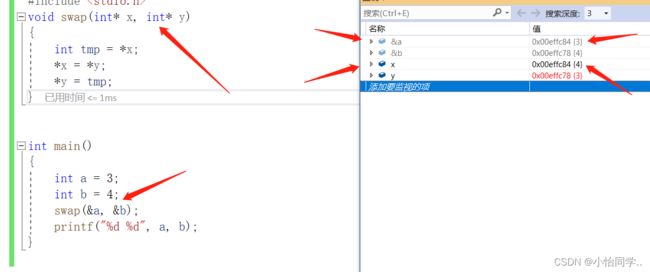数据结构与算法系列之单链表
博客:小怡同学
个人简介:编程小萌新
如果博客对大家有用的话,请点赞关注再收藏
这里写目录标题
- test.h
- SList.h
- 注意事项
-
- 一级指针与二级指针的使用
- assert的使用
- 空链表与顺序表的区别及优缺点
- 详解各接口函数的功能
test.h
#include "SList.h"
void Test()
{
SLTNode* plist = NULL;
SLPrint(plist);
SLPushBack(&plist, 7);
SLPushBack(&plist, 8);
SLPushBack(&plist, 9);
SLPushBack(&plist, 10);
SLPrint(plist);
//SLTNode* ret = SListFind(plist, 8);
//SLPrint(plist);
//SLisTEraseAfter(ret);
//SLPrint(plist);
//SListInsert(&plist, ret, 3);
//SListInsertAfter(ret, 4);
//SlistErase(&plist , ret);
//SLisTEraseAfter(ret);
//SLPrint(plist);
}
int main()
{
Test();
}
SList.h
```c
#include
# SList.c
```c
#include "SList.h"
SLTNode* BuySLTode(SLTDataType x)
{
SLTNode* newnode = (SLTNode*)malloc(sizeof(SLTNode));
if (newnode == NULL)
{
perror("malloc fail");
return NULL;
}
newnode->data = x;
newnode->next = NULL;
return newnode;
}
void SLPrint(SLTNode* phead)
{
SLTNode* cur = phead;
while (cur != NULL)
{
printf("%d->",cur->data);
cur = cur->next;
}
printf("NULL\n");
}
void SLPushBack(SLTNode** pphead, SLTDataType x)
{
assert(pphead);
SLTNode* newnode = BuySLTode(x);
if (*pphead == NULL)
{
*pphead = newnode;
}
else
{
SLTNode* tail = *pphead;
while (tail->next != NULL)
{
tail = tail->next;
}
tail ->next= newnode;
}
}
void SLTPushFront(SLTNode** pphead, SLTDataType x)
{
assert(pphead);
SLTNode* newnode = BuySLTode(x);
if (*pphead == NULL)
{
*pphead = newnode;
}
else
{
newnode->next = *pphead;
*pphead = newnode;
}
}
void SLTPopBack(SLTNode** pphead)
{
assert(pphead);
assert(*pphead);
if ( (*pphead)->next == NULL)
{
free(*pphead);
*pphead = NULL;
}
else
{
SLTNode* tail = *pphead;
SLTNode* prev = NULL;
while (tail->next != NULL)
{
prev = tail;
tail = tail->next;
}
free(tail);
tail = NULL;
prev->next = NULL;
}
}
void SLTPopFront(SLTNode** pphead)
{
assert(pphead);
assert(*pphead);
SLTNode* cur = *pphead;
*pphead = (*pphead)->next;
free(cur);
cur = NULL;
}
SLTNode* SListFind(SLTNode* phead, SLTDataType x)
{
SLTNode* cur = phead;
while (cur)
{
if (cur->data == x)
return cur;
cur = cur->next;
}
return NULL;
}
void SListInsert(SLTNode** pphead, SLTNode* pos, SLTDataType x)
{
assert(pphead);
assert(pos);
if (*pphead == pos)
{
SLTPushFront(pphead, x);
}
else
{
SLTNode* cur = pphead;
while (cur->next != pos)
{
cur = cur->next;
}
SLTNode* newnode = BuySLTode(x);
cur->next = newnode;
newnode->next = pos;
}
}
void SListInsertAfter(SLTNode* pos, SLTDataType x)
{
assert(pos);
SLTNode* newnode = BuySLTode(x);
newnode->next = pos->next;
pos->next = newnode;
}
void SlistErase(SLTNode**pphead, SLTNode* pos)
{
assert(pphead);
assert(pos);
//assert(*pphead);
if (*pphead == pos)
{
SLTPopFront(pphead);
}
else
{
SLTNode* cur = *pphead;
while (cur->next != pos)
{
cur = cur->next;
}
cur->next= pos->next;
free(pos);
}
}
void SLisTEraseAfter(SLTNode* pos)
{
assert(pos);
assert(pos->next);
SLTNode* cur = pos->next;
pos->next = pos->next->next;
free(cur);
cur = NULL;
}
注意事项
一级指针与二级指针的使用
可以看得出来,接口函数传参时有的需要而二级指针,有的需要一级指针
总结为一句话,改变结构体地址需要二级指针,改变结构体(SLTNode)成员需要一级指针。
解析如下
1.根据c语言,实参传址调用与传值调用知识我们可以知道,改变元素大小需要传入地址。而改变地址,则需要传入地址的地址。因为形参只是实参的拷贝 函数销毁之后形参将不存在
2.改变结构体的地址,具体是如何改变呢
通过头指针的地址(pphead这个是二级指针),再解引用得到头指针(headnoe),就可以使用且改变了。
3.通过结构体(headnode),headnode->next可以得到下一个结构体node1
assert的使用
从SList.c可以看出 有时assert(pphead(二级指针)),有时assert(*pphead(一级指针)),
1.当有二级指针传入时,必须使用assert(pphead)断言因为 pphead是头指针的地址 ,虽然头指针 为NULL但是,头指针的地址是真实存在的(也就是地址中的地址)。
2.assert(*pphead)是当链表中已经没有节点存在了,不能进行删除结点的行为。

空链表与顺序表的区别及优缺点
区别
1.顺序表为空时 因为结构体不为NULL,只是 size ==0 链表 phead 为空时,没有节点则头指针为NULL。
2,为什么链表不能和顺序表一样直接size++就可以存入数据呢
因为链表每个节点的地址位置都是malloc函数开辟,每个起点位置可能都不一样。而顺序表相当是开辟一段连续内存空间。
优缺点
一.顺序表存储
优点:顺序表存储是将数据元素放到一块连续的内存存储空间,通过下标 访问高效,直接存储与删除
缺点:1.插入和删除比较慢,需要移动大量元素,
2.开辟空间是不可减少的,不可以动态增加长度,容易造成内存浪费
二 .链表存储
原理:没有空间限制,不会溢出,节省空间内存
优点:插入和删除速度快,只需要改变指针指向即可
缺点:不可通过下标访问,需要遍历节点
详解各接口函数的功能
void SLPrint(SLTNode* phead)
void SLPrint(SLTNode* phead)
{
//不改变结构体地址,只是循环打印数据所以传一级指针
SLTNode* cur = phead;
while (cur != NULL)
{
printf("%d->",cur->data);
cur = cur->next;
}
printf("NULL\n");
}
void SLPushBack(SLTNode** pphead, SLTDataType x)
assert(pphead);//因为二级指针,肯定存在,所以需要断言
SLTNode* newnode = BuySLTode(x);
//判断第一个节点是否为空,改变头节点
if (*pphead == NULL)
{
*pphead = newnode;
}
else
{
SLTNode* tail = *pphead;
while (tail->next != NULL)//寻找最后一个元素
{
tail = tail->next;
}
tail ->next= newnode;//在最后的元素添加节点
}
void SLTPushFront(SLTNode** pphead, SLTDataType x)
assert(pphead);//因为头插改变了头节点,所以传二级指针
SLTNode* newnode = BuySLTode(x);
//当没有节点时,增加节点
if (*pphead == NULL)
{
*pphead = newnode;
}
else
{
newnode->next = *pphead;//增加首节点
*pphead = newnode;
}
void SLTPopBack(SLTNode** pphead)
assert(pphead);//二级指针必须断言
assert(*pphead);//因为当头节点为空时,不能删除
//当只有一个节点时,释放头节点的空间
if ( (*pphead)->next == NULL)
{
free(*pphead);
*pphead = NULL;
}
//当有两个或两个以上的节点时
else
{
SLTNode* tail = *pphead;
SLTNode* prev = NULL;
while (tail->next != NULL)//找到最后一个元素,以及倒数第二个,所以定义了两个指针,因为只找到最后一个并释放后需要把倒数第二个节点(的next)设为NULL
{
prev = tail;
tail = tail->next;
}
free(tail);
tail = NULL;
prev->next = NULL;
}
void SLTPopFront(SLTNode** pphead)
assert(pphead);//二级指针必定不为空
assert(*pphead);//因为链表必须有节点才可以删除,所以需要断言
SLTNode* cur = *pphead;
*pphead = (*pphead)->next;
free(cur);
cur = NULL;
SLTNode* BuySLTode(SLTDataType x)
SLTNode* newnode = (SLTNode*)malloc(sizeof(SLTNode));//开辟一个新节点
if (newnode == NULL)
{
perror("malloc fail");
return NULL;
}
//初始化
newnode->data = x;
newnode->next = NULL;
return newnode;
SLTNode* SListFind(SLTNode* phead, SLTDataType x)
SLTNode* cur = phead;
while (cur)
{
if (cur->data == x)
return cur;//找到返回此节点坐标
cur = cur->next;
}
return NULL;//找不到返回NULL
void SListInsert(SLTNode** phead, SLTNode* pos, SLTDataType x)
assert(pphead);//二级指针必不为空
assert(pos);//判断pos是否为有效地址
//判断头节点是否可以插入
if (*pphead == pos)
{
SLTPushFront(pphead, x);
}
else
{
SLTNode* cur = pphead;
while (cur->next != pos)//找到pos之前的位置
{
cur = cur->next;
}
SLTNode* newnode = BuySLTode(x);
cur->next = newnode;//链接新的节点
newnode->next = pos;
}
void SListInsertAfter(SLTNode* pos, SLTDataType x)
assert(pos);//判断pos位置
SLTNode* newnode = BuySLTode(x);
//链接新的节点
newnode->next = pos->next;
pos->next = newnode;
void SlistErase(SLTNode** pphead, SLTNode* pos)
assert(pphead);//二级指针必不为空
assert(pos);//pos位置是否合理
assert(*pphead);/删除一个节点,所以链表必不为空
//改变了头指针,地址改变需要二级指针
if (*pphead == pos)
{
SLTPopFront(pphead);
}
else
{
SLTNode* cur = *pphead;
while (cur->next != pos)
{
cur = cur->next;
}
cur->next= pos->next;
free(pos);
}
void SLisTEraseAfter(SLTNode* pos)
assert(pos);//判断pos位置是否合理
assert(pos->next);//因为要删除pos的下一个位置的节点,所以只有一个节点不能删除
SLTNode* cur = pos->next;
pos->next = pos->next->next;
free(cur);
cur = NULL;



